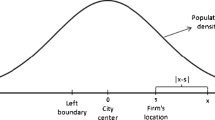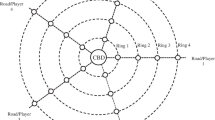Abstract
Compelling empirical evidence suggests that people move in response changes in pollution and that firms move in response to regulation. We investigate the problem of benefit estimation and transfer in the context of a simple model where firms and people can move in response to regulation and pollution. Including these margins of adjustment changes the problem of benefit-transfer. It requires the evaluation of policies that affect more than one region at a time. This suggests an important role for evaluation strategies based on easily observable indicators of local welfare like total population, real income net of real estate, or the use of elementary standardized models of spatial equilibrium.
Similar content being viewed by others
Notes
More detailed micro-foundations consistent with this specification are developed in Desmet and Rossi-Hansberg (2013).
This is a common simplifying assumption in spatial models. It allows me to avoid the cumbersome problem of specifying an ownership structure for land and recirculating land rent through the economy.
Higher levels of trade, income constant, are good because they suggest more specialization in activities where there is a local comparative advantage.
Each city is, therefore, slightly more complicated than the basic Rosen–Roback city in that it allows for a government sector which provides local public goods.
There is no reason to think that the Clean Air Act affects government productivity, so these parameters all stay unchanged from the Desmet and Rossi-Hansberg (2013) estimates. Indeed, one can imagine a simpler version of their model without a government sector at all.
Note that this echoes the problem of determining local labor employment elasticities. The way a region responds to an employment shock appears to depend, for example, on how easy it is for people to commute into this market or how elastic is the housing supply.
References
Albouy D, Graf W, Wolff H, Kellogg R (1982) Extreme temperature, climate change, and american quality of life. J Assoc Environ Resour Econ 3(1):205–246
Becker R, Henderson V (2000) Effects of air quality regulations on polluting industries. J Polit Econ 108(2):379–421
Chay KY, Greenstone M (2005) Does air quality matter? Evidence from the housing market. J Polit Econ 113(2):376–424
Desmet K, Rossi-Hansberg E (2013) Urban accounting and welfare. Am Econ Rev 103(32):2296–2327
Diamond R (2016) The determinants and welfare implications of US workers’ diverging location choices by skill: 1980–2000. Am Econ Rev 106(3):479–524
Dornbush D, Abel F (1973) Benefit of water pollution on property values. EPA Technical paper 600/5-73-005
Duranton G, Turner MA (2012) Urban growth and transportation. Rev Econ Stud 79(4):1407–1440
Fujita M, Ogawa H (1982) Multiple equilibria and structural transition of non-monocentric urban configurations. Reg Sci Urban Econ 12(2):161–196
Gollop FM, Roberts MJ (1983) Environmental regulations and productivity growth: the case of fossil-fueled electric power generation. J Polit Econ 91(4):654–674
Gonzalez-Navarro M, Turner MA (2016) Subways and urban growth: evidence from earth. Processed, Brown University
Greenstone M (2002) The impacts of environmental regulations on industrial activity: evidence from the 1970 and 1977 Clean Air Act amendments and the census of manufactures. J Polit Econ 110(6):1175–1219
Greenstone M (2003) Estimating regulation-induced substitution: the effect of the Clean Air Act on water and ground pollution. Am Econ Rev 93(3):442–448
Johnston RJ, Rolfe J, Rosenberger RS, Brouwer R (2015) Introduction to benefit transfer methods. In: Johnston RJ et al (eds) Benefit transfer of environmental and resource values. Springer, Dordrecht, pp 19–59
Keiser DA, Shapiro JS (2016) Consequences of the Clean Water Act and the demand for water quality. Processed, Yale University
Kuminoff NV (2012) Partial identification of preferences in a dual-market sorting equilibrium. Processed, University of Arizona
Kuminoff NV, Pope JC (2016) Do “capitalization effects” for public goods reveal the public’s willingness to pay? Processed, University of Arizona
Redding S (2016) Goods trade, factor mobility and welfare. J Int Econ 101:148–167
Roback J (1982) Wages, rents, and the quality of life. J Polit Econ 90(6):1257–1278
Ryan SP (2012) The costs of environmental regulation in a concentrated industry. Econometrica 80(3):1019–1061
Smith VK, Van Houtven G, Pattanayak SK (2002) Benefit transfer via preference calibration: “prudential algebra” for policy. Land Econ 78(1):132–152
Turner MA, Haughwout A, Van Der Klaauw W (2014) Land use regulation and welfare. Econometrica 82(4):1341–1403
Walker WR (2013) The transitional costs of sectoral reallocation: evidence from the Clean Air Act and the workforce. Q J Econ 128(4):1787–1835
Author information
Authors and Affiliations
Corresponding author
Additional information
Guest Editor: V. Kerry Smith.
I am grateful to Kerry Smith for helpful conversations and encouragement, to Cassandra Cole for helpful research assistance, to Nicholas Kuminoff and David Simpson for helpful comments, and to the EPA and Abt for financial support. The author retains sole responsibility for errors.
Rights and permissions
About this article
Cite this article
Turner, M.A. Benefit-Transfer and Spatial Equilibrium. Environ Resource Econ 69, 575–589 (2018). https://doi.org/10.1007/s10640-017-0213-9
Accepted:
Published:
Issue Date:
DOI: https://doi.org/10.1007/s10640-017-0213-9




